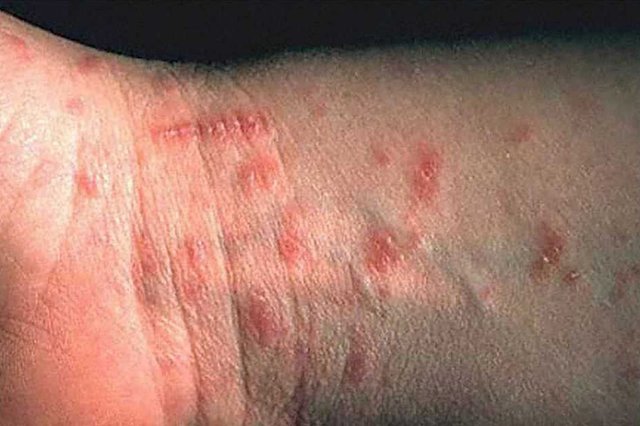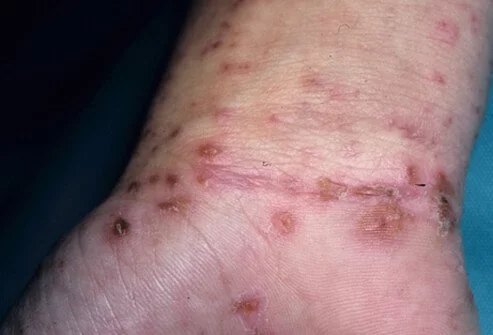Scabies : Skin Disease

Scabies is a highly contagious parasitic skin infection caused by the itch mite Sarcoptes scabiei.
It mainly spreads prolonged direct skin to skin contact with infested person. Sometimes sharing articles like towels, bed or clothing may spread it. Incubation period (time from infestation to onset of symptoms) is 3- 6 weeks, but is shorter in person with prior scabies. The adult female parasite burrows into the upper layer of the skin where she lays eggs, which hatch into larvae and the progress to adult mites in about 10 days.
Risk Factors
Direct skin to skin contact with infested person, which can occur in the following situations:
Overcrowded conditions such as nursing homes, extended-care facilities, and prisons etc. where people are in close proximity to one another.
If the individual has intimate personal contact, such as sexual intercourse.
If the individual shares clothes, bedding, or towels of an infected person.
People with weak immune system (HIV or AIDS) can develop severe infection known as crusted scabies.
Infested person can spread the disease before they develop symptoms.
Symptoms

Intense itching in affected areas which is worse at night.
Common sites are finger webs, wrist, elbow, around the nipple, armpit, popliteal folds, inguinal region, groin region, edges of the feet, gluteal fold, penis, and scrotum.
Bacterial skin infection (redness, fever, pus ) due to scratching.
Diagnosis
History of intense itching, other members of household with similar symptoms and typical distribution of skin lesion help in diagnosis. Definite diagnosis can be made when skin scrapings show mites under the microscope.
Treatment Options
Scabies is a treatable condition. Goal of treatment is eradication of mites, provide symptomatic relief and prevent further spread of scabies. More than one application may be needed to kill all the mscabiei
Permethrin 5 % : applied thoroughly into the skin surfaces from the head to the soles of the feet. It is best to apply at bedtime and then wash it off in the morning.
Benzyl benzoate (25%) may be used as an alternative topical agent to permethrin. However, this agent may cause immediate skin irritation. Lower concentrations may be used in children (10% or 12.5%).
Crotamiton lotion 10% can be used.
Lindane 1% cream or lotion is used less because it is potentially toxic to the nervous system (leading to seizures).
Crusted scabies requires oral Ivermectin.
Symptomatic Treatment
Soothing lotion like calamine lotion can be used to minimize itching.
Antihistamines, such as diphenhydramine can be prescribed to provide relief from itching. Itching may continue for 2-4 weeks after treatment because itching is due to allergic reaction.
Topical or oral steroids may be needed to reduce the swelling and itching.
Prevention of Scabies
Wear clean clothes after treatment
Used clothes are washed in hot water (scabies mites die when exposed to 50 degree C or 112 degree F for 10 minutes) and dried in hot dryer.
Entire household and other contacts should be treated at the same time.
When to seek Medical Care?
When a typical rash (tiny red spots) is found anywhere in the body with uncontrollable itching and you suspect that it is scabies
When you are exposed to person with scabies
When the skin is broken or injured due to scratching, secondary bacterial infections of the skin is developed. Sometimes life-threatening condition may develop when the infection enters the blood.
If the symptoms persist and shows no signs of improvement even after four weeks of treatment.
People, who develop crusted scabies, often need repeat treatments to get rid of the mites.
No improvement in symptoms after treatment.
Source
It is one of most contagious skin problem. One person in household is affected means most probably others will be affected too as well.
By the way, getting flagged by cheetah is not good in long term. If it is your articles from elsewhere, you have to mention that. Copy and paste is really discouraged here. Hope that you will understand that.
Good luck.
